I remember the first time I saw polished pebble walls in a home.
The cool gray tones totally blew me away.
But it wasn’t until I started shopping for a new area rug that it really hit me – choosing the right carpet is crucial when you’ve got pebbles on the walls.
Too dark and it’ll make the space feel closed in.
Too light and it’ll disappear against the backdrop.
After trying way too many color combos, I finally narrowed it down to these versatile shades that will seriously level up your pebble palace.
The key is looking for hues with a similar tone and depth as the stones.
Warm, muted tones tend to pair best.
You’ll be floored by the polished look.
Here are the top 18 carpet colors recommended to pair with polished pebble walls:
✨Click to Get My 101 FREE Designer Room Ideas
Light Gray
Nothing makes polished pebbles pop like a soft light gray carpet.
As the lightest color on the list, light gray mimics the hue of the pebble walls but brightens up the space.
It provides just enough contrast to lift the walls without overwhelming them.
The subtle differentiation prevents the room from looking flat and one-dimensional.
Opt for a light gray with hints of beige or taupe undertones for a lived-in, organic feel.
The understated tone ties the whole space together without competing for attention against the beautiful pebble feature wall.
It allows the pattern and texture of the stones to really shine.
By echoing the walls’ cool gray palette, light gray emphasizes the three-dimensional detail of the pebbles.
The subtle 5-10% contrast between the tones prevents the room from looking one-dimensional and flat.
Opt for a light gray with hints of cooler beige or taupe undertones rather than warmer grays for a fresher, crisper vibe.
Go for a soft, silky texture too – it won’t compete visually with the textured stone surface but will play off it nicely.
A light gray carpet allows the natural beauty of the pebbles to take center stage.
Its understated tone expertly ties the whole space together without stealing the spotlight from the featured wall installation.
It recedes into the background just enough for guests to focus their attention on the unique detailing of the stones.
At the same time, the gentle contrast emphasizes the three-dimensional ripples, swirls and edges of the pebbles by making them stand apart from the carpet plane underneath.
The dimensional interplay between surfaces creates visual interest that makes viewers linger.
So if you want your substantial pebble feature wall to sing, lay down a light gray carpet – it’s the easiest way to let those polished rocks pop!
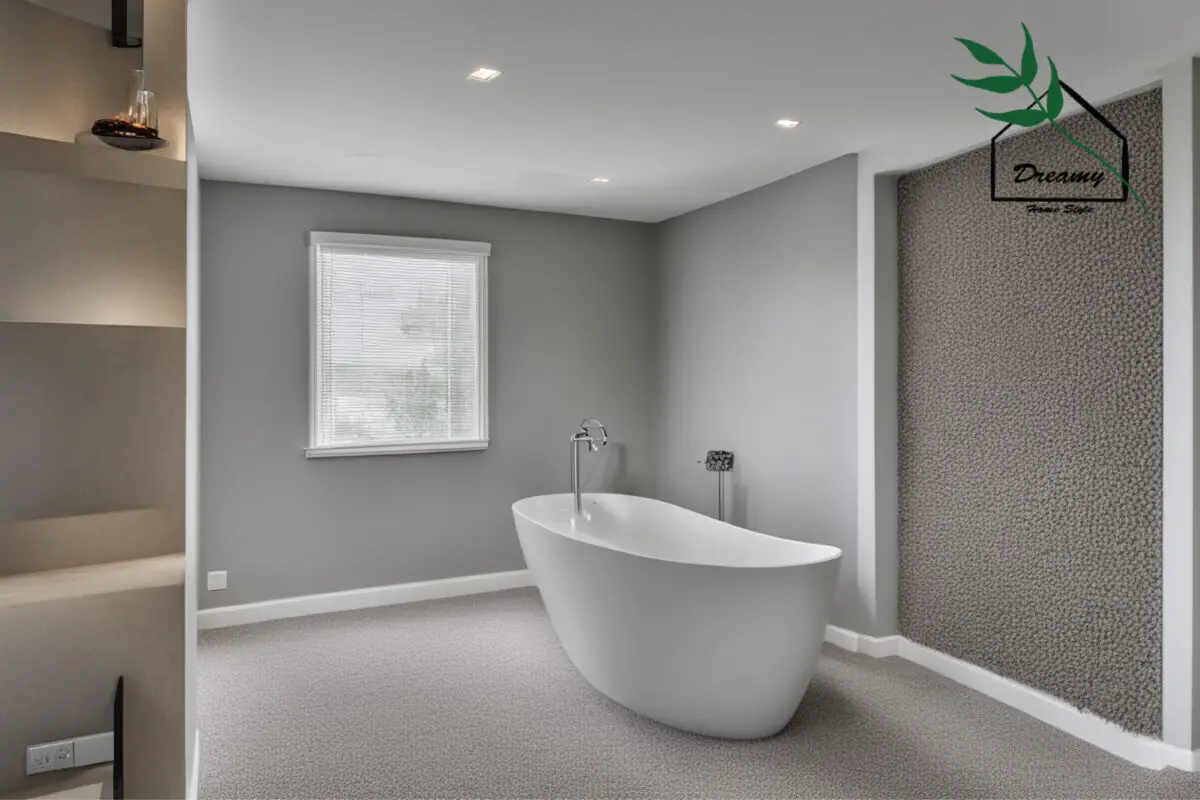
Taupe
An earthy taupe is the perfect carpet color to complement polished pebble walls.
Where light gray provides a cooler, brighter contrast, taupe introduces just the right amount of visual warmth through its neutral brown-gray hue.
This echoes the aged, organic aesthetics of naturally weathered stones.
Taupe’s subtle undertones subtly reference other natural materials like suede, weathered concrete, or beach sand.
The 10-15% contrast it provides against the pebbles’ cooler gray tones is more eye-catching than a light gray would be, so it prevents the walls from blending into the background.
At the same time, taupe has slightly more depth and dimension in its shade compared to straight gray.
This extra pop of color allows the dimensional texture of the pebbles, with their varied ripples, ridges and striations, to truly stand out in striking clarity and definition.
The warm brown undertones also accentuate the nuanced shading within individual stones, from lighter striations to darker veins and flecks.
Perhaps most importantly, taupe’s rounded, blended tone acts as the perfect flattering backdrop and complementary canvas for the pebble feature wall.
It serves to highlight the statement element without competing for visual attention itself.
And its organic, earthy warmth diffuses cooler gray undertones to create a comfortable and inviting interior space.
With a taupe carpet grounding the design, the pebble installation becomes the stylish, textured centerpiece it was meant to be.
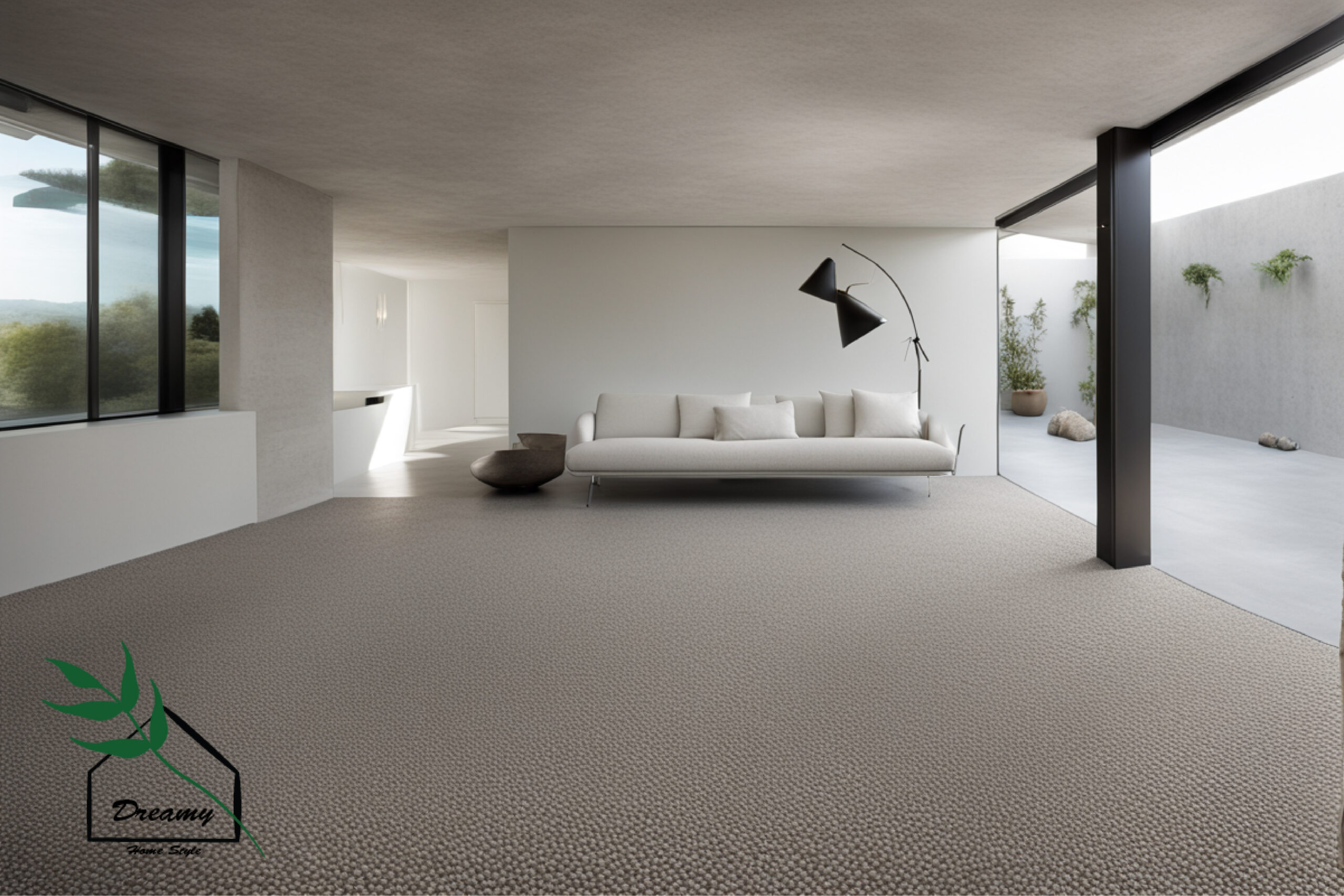
Cement
As a home designer, I always say that cement gray is one of those bold colors that really ties modern spaces together.
For polished pebble walls, a cement gray carpet choice intensifies the industrial edge of the design.
The cool charcoal hue coordinates seamlessly with the pebbles without being matchy-matchy.
This creates a cohesive look while still allowing each material to shine on its own.
I love how cement gray accentuates the texture in the pebbles even more so than a lighter shade.
Its deeper color intensity makes the dimensional ripples really pop off the page.
It emphasizes the stony variations from afar rather than just mimicking tone.
This makes the pebble detail absolutely captivating to admire.
I also appreciate how gray concrete references modern architecture and infrastructure.
It lends the space an urbane, dramatic aesthetic.
From a maintenance perspective, cement gray makes dirt less noticeable compared to lighter options.
However, be sure to choose a tightly-woven fiber as it will still show stains.
As a designer, I’d suggest accenting the industrial ambiance further with open shelving, galvanized accents, and geometric art.
Don’t be afraid to mix wood tones too for warmth.
A bluestone coffee table would look divine.
Overall, cement gray is a bold move but it’s sure to make any polished pebble feature the star attraction for years to come.
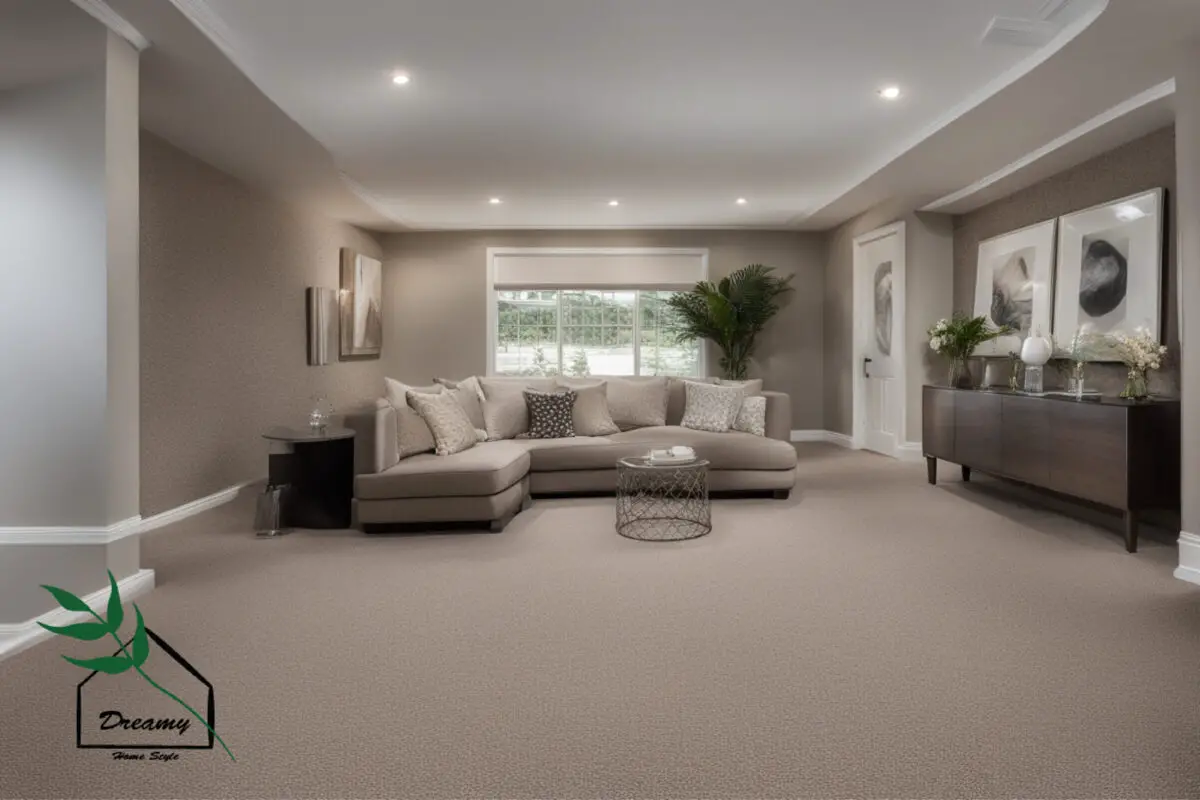
Dusty Rose
I’m always on the lookout for ways to inject soft femininity into modern spaces.
A dusty rose carpet does just that while beautifully complementing pebble walls.
The pale pinky-beige hue introduces delicate warmth that offsets the stones’ cool gray tone.
I adore how rose dusts of pigment gently lift the pebbles without overwhelming them.
It allows their texture to really breathe and come into focus.
From my perspective, dusty rose works because its muted saturation meshes perfectly with the faded, vintage aesthetic many pebble installations conjure.
The subtle 10% contrast makes the walls feel gracefully curated rather than starkly decorated.
I also appreciate how the blush tone flatters other natural materials.
For example, positioning a willowy rattan chair or bleached wood side table beside the rose carpet and pebbles creates an effortless coastal charm.
As far as styling suggestions, I’d pick out accent pillows, a plush throw, and framed botanical prints in similar muted corals, pinks and greens to enhance the calm delicacy.
My favorite vignette uses solid plaster panels, jute rugs, and pampas grass to further the textural romance.
Overall, dusty rose carpet brings out the lovely subtleties in any stony backdrop through its quiet feminine grace.
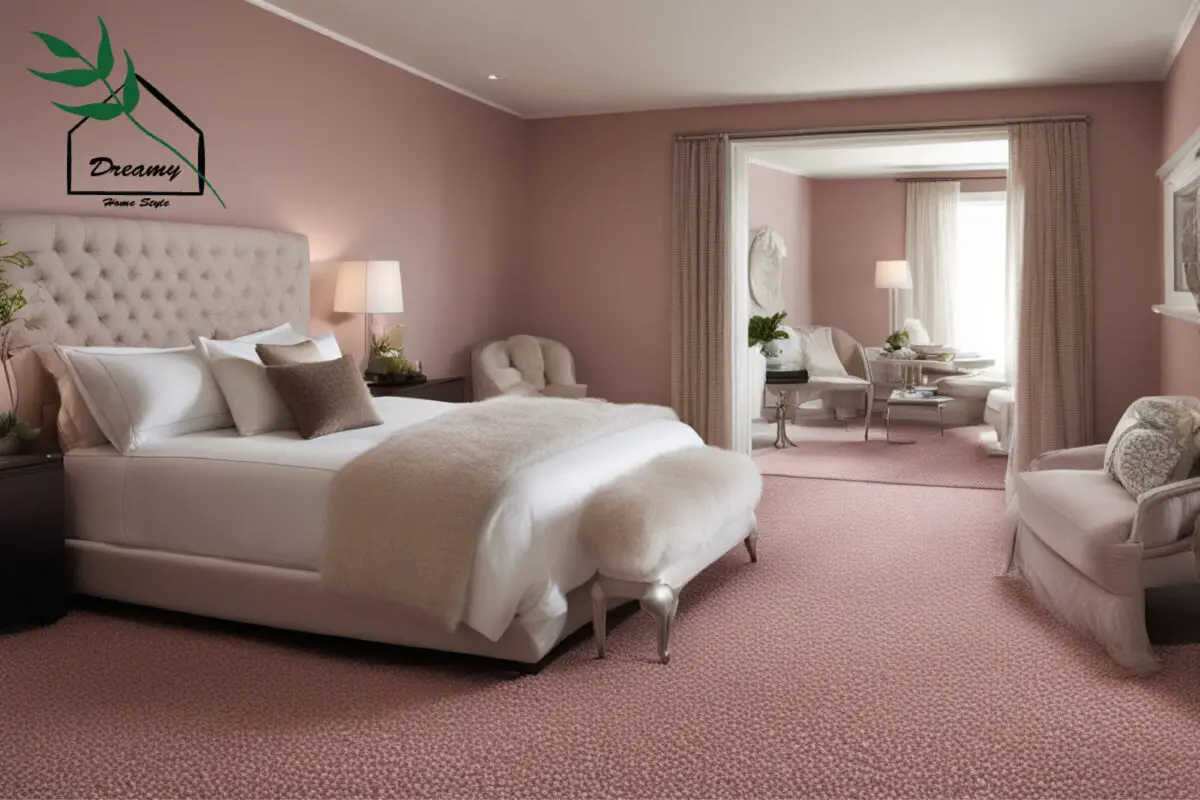
✨Click to Get My 101 FREE Designer Room Ideas
Light Olive
As a designer, one of my favorite neutral shades is a light olive green.
Its subtle hue has a way of adding warmth and visual depth without dominating a space.
For pebble walls, an olive carpet creates a tasteful contrast that really allows the stones’ intricate textures to shine through.
The 10-15% difference between the tones is just peppery enough to break up any monotony without overwhelming the natural motif.
I appreciate how olive’s pale vagrancy accents the pebbles’ subtle color variations, from veins of smoky quartz to flecks of golden mica.
It brings out nuanced dimension in the surface that lighter grays can’t quite achieve.
The warm undertone also makes the walls appear more organic and embedded in their surroundings.
It feels harmonious with natural elements rather than jarringly crisp.
In terms of styling recommendations, I think walnut and gold accents would look exquisite with the olive-pebble palette.
Try a brass lamp, brown leather chairs, and framed photos of lush foliage.
Potted Fiddle Leaf Figs would add verdant texture too.
Finally, I love the visual continuity of using earthenware planters and organic-shaped coffee tables to tie the naturalistic scheme together.
To me, this livelier olive carpet makes pebbles truly shine like facets of gold.
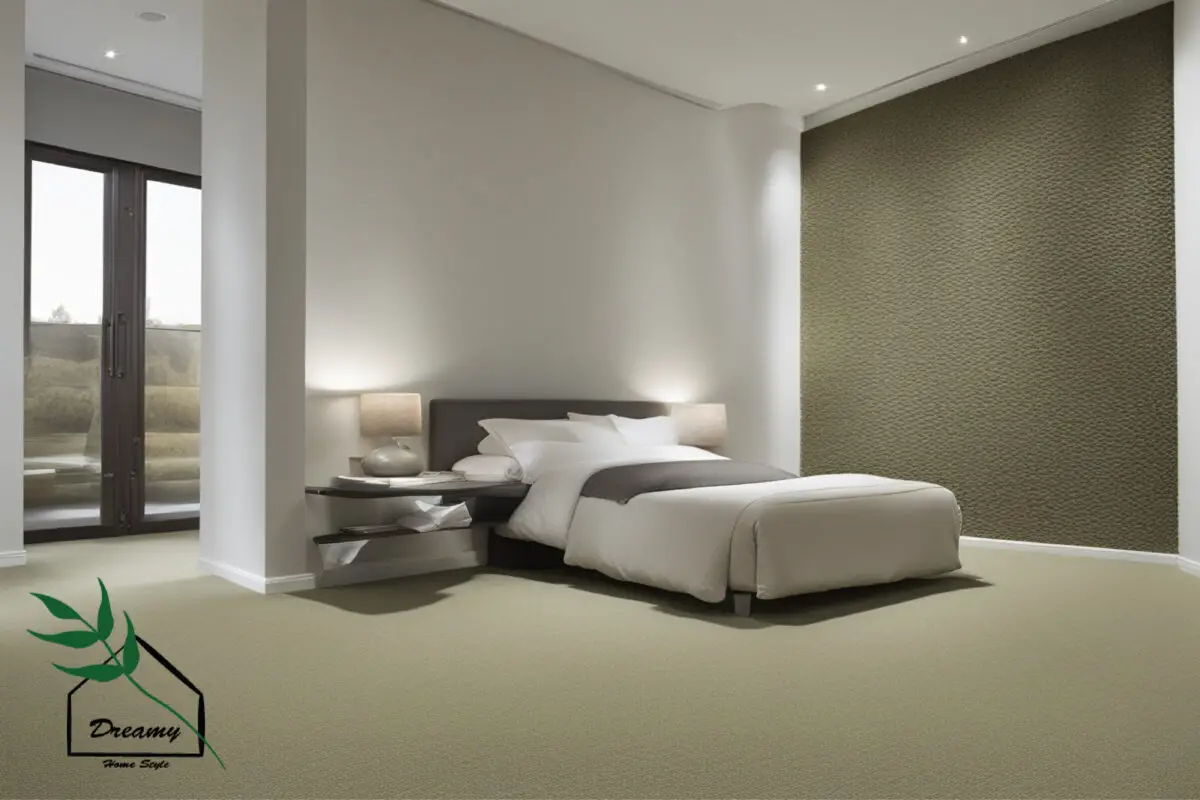
Pale Yellow
I think pale yellow is an unexpected yet stunning choice for pebble walls.
While most assume gray or tan, this subtly sunny hue beautifully brings out warmer subtleties in the stones.
The high-key yellow acts as a reflector that bounces light around the space.
This makes the pebble textures appear illuminated from within.
I appreciate how the subtle 10% contrast allows ripples, flecks and crags to achieve true definition against the creamy backdrop.
Though pale, this carpet acts as a visual conductor that energizes the walls.
From my perspective, yellow works so well because many stones contain veins of gold, sienna and chamomile – colors this carpet literally enhances.
The warm reflection creates an organic glowing effect, as though sunlight appears baked into the rock.
In terms of styling, I always pair yellow with sage and blush for a feminine lift.
Try draping fabrics in these echoed hues or showcasing artwork with similar palettes.
Braided rugs and wicker baskets lend cottage appeal.
An unusual move, I know – but between you and me, pale yellow makes a pebble feature sing like nothing else.
The subtle contrast amplifies intricate detail for a look that’s luminously layered and light.
Dove Gray
I’m drawn to dove gray’s delicately nuanced hue for pebble walls.
Where charcoal seems harsh, and taupe too warm, dove gray strikes the perfect midpoint between cool and cozy.
Its pale, ash-tinged sophistication lifts pebbles in a comfortably understated way.
Rather than boldly contrasting, dove gray acts as a canvas that allows natural variations within the rock face to emerge.
I appreciate how it distinguishes subtle shadows and highlights that truly make the texture pop off the plane.
The 10% contrast opens up beautiful definition without overwhelming delicate details.
The barely-there differentiation also makes individual pebbles appear artistically arranged rather than starkly positioned.
To my eye, this cultivated look is perfectly balanced.
In terms of styling suggestions, accessorizing with soft creams, blush pink and mossy green pillows would enhance dove gray’s gentle refinement.
Accent pieces like curvy ceramics, wood-framed photos and burlap-covered books draw out warm, earthy nuances as well.
Ultimately, as a designer, I think dove gray carpet has an elegant, easy-breathe way of letting pebble walls shine through naturally.
By enhancing natural light and shadow play, it becomes an artful backdrop for the curated scene.
Blush Pink
I love how blush pink introduces a sweet, feminine element to accent pebble walls.
Where gray feels sterile, pink adds life.
Its subtle coral undertones lend vibrancy while remaining soft enough not to overpower the stones.
I appreciate how blush blossoms like petals against the neutral backdrop.
The 10-15% contrast opens pores and crevices in the rockface to drifting light.
Shades within each pebble pop with luminous definition.
To my eye, pink works because it references warmth hidden in stones.
Many contain rose quartz flecks or ivory veins that this colorful canvas draws forward.
It makes the texture feel illuminated from within like a sunrise.
In terms of styling, pair blush with creams, sage and copper accents for vintage charm.
Try draping luxurious velvet, positioning terra cotta planters or styling with dried floral arrangements and mercury glass frames.
As a designer, I’d finish with a polished nickel console, blush candles and a rattan peacock chair to tie the layered look together.
Overall, blush pink creates a romantic, rosy spotlight for pebbles’ true beauty to shine through like a natural work of art.
✨Click to Get My 101 FREE Designer Room Ideas
Dusty Pink
As a designer, I’m drawn to how dusty pink creates an organic, lived-in contrast for pebble walls.
Its pale, blush-beige tone references seashells and faded florals without competing with the stones’ neutral palette.
I appreciate how dusty pink reflects light in a way that contours and defines each pebble’s textured surface.
Though subtle, the 10-15% difference makes intricate lines and shapes pop with enhanced shadow.
It flatters without forcing.
The gentle contrast also allows natural variations within the rock face to shine through like stripes in agate or veins of rose quartz.
It feels curated rather than starkly positioned.
In terms of styling, I think curled velvet chairs and chunky knits and throws and linens would enhance dusty pink’s casually elegant feel.
Brass accents and potted succulents add relaxed polish.
Finally, styling with natural elements like pampas grass, stacked books and woodgrain accessories ties this look together seamlessly.
To me, dusty pink makes any pebble feature feel gracefully lived-in and artfully aged.
It’s a designer’s dream – functional beauty that lets materials sing on their own quiet terms.
Sage Green
Sage green is one of my favorite unexpected choices for pebble walls.
While gray is safe, this subtle tone infuses freshness and dimension.
I love how sage lifts cool tones in the stones towards a brighter, olive hue.
The 10-15% contrast makes intricate grooves and nicks pop like veins in agate or striations in jade.
Its verdant reflectiveness enhances subtle colors that flat gray misses.
Where gray feels sterile, sage references nature.
It grounds the space while playing up pebbles’ inherent nature motif.
The inviting tone makes them appear curated from surrounding landscape instead of harshly constructed.
In terms of styling suggestions, pair sage with varying wood tones, rattan, and natural fabrics.
Copper accents introduce burnt sienna in aged patinas.
I’d style with jute runners, bleached driftwood, potted succulents and framed close-up botanicals.
Bringing outdoors inside ties the look together seamlessly.
Ultimately, as a designer, I think sage green brings the elegant wildness out in any pebble installation.
Its flattering reflection emphasizes inherent beauty instead of heavy contrasting.
It’s an organic way for stones to shine through as naturalistic art.
Sand
I’m drawn to how a sand carpet references pebbles’ natural beachside origins.
Its pale beige-tan hue introduces gentle texture against neutral tones without overwhelming delicate details.
I appreciate how sand’s warm reflectiveness illuminates the walls from within.
Subtle shadows and striations appear to drift against the shoreline backdrop.
It also references how pebbles are naturally weathered, smoothing subtle color variations.
No pebble appears starkly placed but artfully arranged by time.
In terms of styling suggestions, I think woven rattan, seagrass, and natural cottons enhance sand’s seaside character.
Driftwood accents and shell-filled vessels add beachy charm.
Building a vignette with a whitewashed credenza, bleached wood art, and a wicker chaise would transform the space into a breezy coastal escape.
Ultimately, sand carpet creates a feeling that these walls were discovered, not just installed.
It’s a nostalgic, welcoming effect that lets pebbles shine in their natural light-reflecting glory.
Oatmeal
As a designer, oatmeal’s neutral warmth is a perfect complement to pebble walls.
Where gray seems stark, this creamy beige introduces relaxed dimension and tactile coziness.
I appreciate how oatmeal’s subtle reflectiveness enhances natural details without harsh contrast.
It references an organic, soothing quality found in stones naturally weathered smooth by waves.
No pebble appears flatly affixed but artfully incorporated.
In terms of styling, pairing oatmeal with varying wood tones brings out inherent beauty.
Mixing bleached driftwood, macramé, and jute ropes lend beachy casualness.
I’d include natural textures like seagrass baskets of shells and potted succulents to emphasize flow between elements.
Warm metals like brass and copper accents introduce an earthy spark.
Finally, cushioned window seats and plush woven textiles encourage relaxation against this calm, cradling backdrop.
As a designer, oatmeal allows pebbles to retain their innate character beautifully.
Overall, its mellow reflection creates a welcoming, nostalgic coastal atmosphere where intricate details shine through softly.
It’s a perfectly flexible, flattering foundation.
✨Click to Get My 101 FREE Designer Room Ideas
Willow
Its pale green-gray tone lifts cooler shades while still respecting neutral earthiness.
I love how willow’s lightweight reflectiveness illuminates minute details from within.
The 5-10% contrast brings out intricate veins, stripes and textures like grooves in jade or striations in agate.
This enhancement spotlights inherent beauty.
Where gray feels flat, willow references calm natural elements.
It evokes reeds swaying gently along a stream bank where the walls appear gathered.
No stone looks harshly affixed but thoughtfully arranged.
In terms of styling, pairing willow with varying wood tones, sea grass, and rattan introduces soft linear accents.
Potted ferns and monstered leaves borrow from its verdant palette.
I’d include objects like stacked water-worn books, mercury glass frames with botanical prints, and a curved ceramic console in muted tones to flow with the look.
Warm metals like weathered copper introduce subtle sparkle.
Overall, as a designer, I find willow’s tender reflectiveness showcases pebbles’ balanced calm character beautifully.
It prioritizes inherent natural essence over stark contrast.
Mist
Mist is an ethereal choice that enhances pebbles’ inherent subtleties.
Its pale gray-blue tone lifts cooler shades while keeping walls breezily light.
I appreciate how mist illuminates intricate variances from a soft reflected glow.
Where stark gray feels heavy, mist references wispy natural elements.
Walls drift like an early morning shoreline where stones arrange themselves on retreating tidewaters.
No edge feels harsh.
In terms of styling, mist pairs beautifully with driftwood, seashell accents and weathered sailcloth in muted aquas.
Horizon landscapes and mermaid-scaled mirrors borrow its watercolor palette.
Distressed rattan peacock chairs and curved ceramic vessels lined with sea glass keep the space airily textural.
Natural rattan runners flow between elements.
Finally, little additions like a glass buoy filled with sand dollars or striped agate stones on woodgrain tables tie details together charmingly.
Overall, mist creates a dreamlike backdrop for pebbles’ true beauty to breathe freely as fine artwork.
Pale Purple
I think pale purple introduces an elegant floral element that enhances pebbles’ natural tones in an unexpected way.
I appreciate how purple references inherent qualities found in stones like amethyst geodes or quartz veins.
Walls take on an organic aura as if installed in an enchanted garden.
In terms of styling, porcelain flower arrangements and embroidered cushions in lavender, blush and mint borrow from its soothing palette.
Distressed wood and wicker accents introduce tactile contrast.
Groupings of potted hydrangeas, foxglove and clipped boxwood hedges emphasize purple’s floral motif.
Frosted glass shutters allow diffused natural light to filter through.
Mercury glass frames with botanical prints and a curved ceramic console introduce reflective sparkle.
Warm metals like weathered copper add earthy punctuation.
Ultimately, pale purple creates a serene backdrop where pebbles appear arranged by gentle breezes rather than crafted by hand.
It’s a place for natural beauty to breathe freely.
Dusty Violet
As a designer, I find dusty violet introduces an elegant aged quality that flatters pebble walls beautifully.
Its pale periwinkle-gray hue lifts subtle purple and lavender tones seen in minerals like amethyst or fluorite.
Where stark gray feels harsh, dusty violet references qualities found in stones smoothed by centuries.
Walls appear installed in a garden courtyard taking on patina over seasons.
In terms of styling, draping pale linens and pairing with aged porcelain, mercury glass, and moss green botanicals draws out its vintage feel.
Distressed wood and wicker accents introduce tactile contrast.
Gilded framed pressed flower art, potted succulents in terracotta and a white-washed credenza filled with crystal keep the layered look flowing.
Gentle sconces cast a dreamlike sheen.
Overall, as a designer, I find dusty violet creates a tranquil backdrop where pebbles appear curated over centuries rather than newly crafted.
It’s a place for inherent natural beauty to subtly shine through like a work of organic art.
✨Click to Get My 101 FREE Designer Room Ideas
Clay
Clay introduces an earthy richness that enhances pebbles’ natural tones beautifully.
Its warm ochre-brown hue picks up elements found within stones like veins of sienna or flecks of umber pigment.
Where gray feels flat, clay references qualities found in stones weathered in desert environs.
Walls take on a feeling of being unearthed rather than fabricated.
In terms of styling, pairing clay with hemp and jute textiles draws out its organic tactility.
Rust and moss accents like terra cotta planters and driftwood sculptures add warmth.
Clustering potted succulents, stacked river stones, and woven baskets of agates introduces layered visual interest.
A bentwood bench and camel accessories lend desert flair.
Finally, soft ceramics, mercury glass, and gilded frames keep the space flowing lightly.
Overall, clay creates a sense that walls were purposefully curated from their origin habitat.
It brings out pebbles’ innate character beautifully.
Dusty Aqua
I love how its soft reflectiveness illuminates intricate mineral striations, bringing subtle variations alive like tide pools at dawn.
Though only 5-10% contrast, intricate textures float against the backdrop dreamily.
Where stark gray seems sterile, dusty aqua references the fluid, natural qualities water leaves in stones smoothed by waves.
Walls take on an appearance of being gathered from shorelines over time.
In terms styling, pairing dusty aqua with bleached driftwood, jute, and rope accents draws out its beachy tactility.
Shell-encrusted ceramics and woven seagrass baskets add naturalism.
Clustering potted succulents and ferns with tucked-in-seashell details introduces layered visual depth.
Distressed rattan and fibers like abaca fabric lend casual elegance.
Finally, touches like a whitewashed credenza filled with mercury glass and a curved driftwood mirror keep the space flowing softly.
Overall, it highlights pebbles’ innate beauty as naturally as the tides.
In conclusion, as a designer I find that choosing the right carpet color plays an integral role in making pebble walls truly sing.
While neutral tones like gray are safe options, more unexpected hues can unlock an installation’s hidden potential.
By referencing elements found in nature like the hues of sea glass, desert sands or forest moss, complementary colors flatter pebbles’ natural innateness rather than starkly contrasting.
Most importantly, a well-curated color brings out walls’ inherent tonality as organic works of art rather than sterile constructions.
It allows regional accents within each rock to breathe subtly like ripples in sand, stripes in agate or natural crystalline structure.
With thoughtful stylistic pairings and layered decorative accents, the right hue also shapes spatial mood from serene gardens to drifting shorelines.
It transforms a space into an effortless backdrop for pebbles’ quiet beauty to shine through without distraction.
Ultimately, carving out pebble walls’ innate character is what true design is about.
A supportive, considered backdrop lets natural materials take center stage on their own quiet terms.
With a delicate reflective quality, the right carpet color achieves functional beauty that enhances inherently over powers.


